HRM 580 Capstone: Strategies for HRM in Manufacturing Company
VerifiedAdded on 2021/10/13
|40
|10102
|33
Project
AI Summary
This Capstone project for HRM 580 analyzes the role and functions of a human resources department within a large manufacturing organization, specifically examining the case of Ellard Williams, Inc. The project explores the five most important duties of an effective HR department: staffing, development, compensation, safety and health, and employee and labor relations, detailing how these duties support the organization's strategic objectives. It delves into environmental and organizational factors affecting financial performance, such as liquidity and firm size, and how the HR department can mitigate their impact. The project also covers union and labor management relations, compensation strategies, recruitment and selection processes, and the importance of a team-oriented culture and organizational health. Furthermore, it recommends strategies for HR professionals to enhance their knowledge and skills, providing a comprehensive overview of HRM best practices to improve employee motivation, performance, and productivity within a manufacturing context. The project emphasizes how effective HR practices are crucial for achieving organizational success.
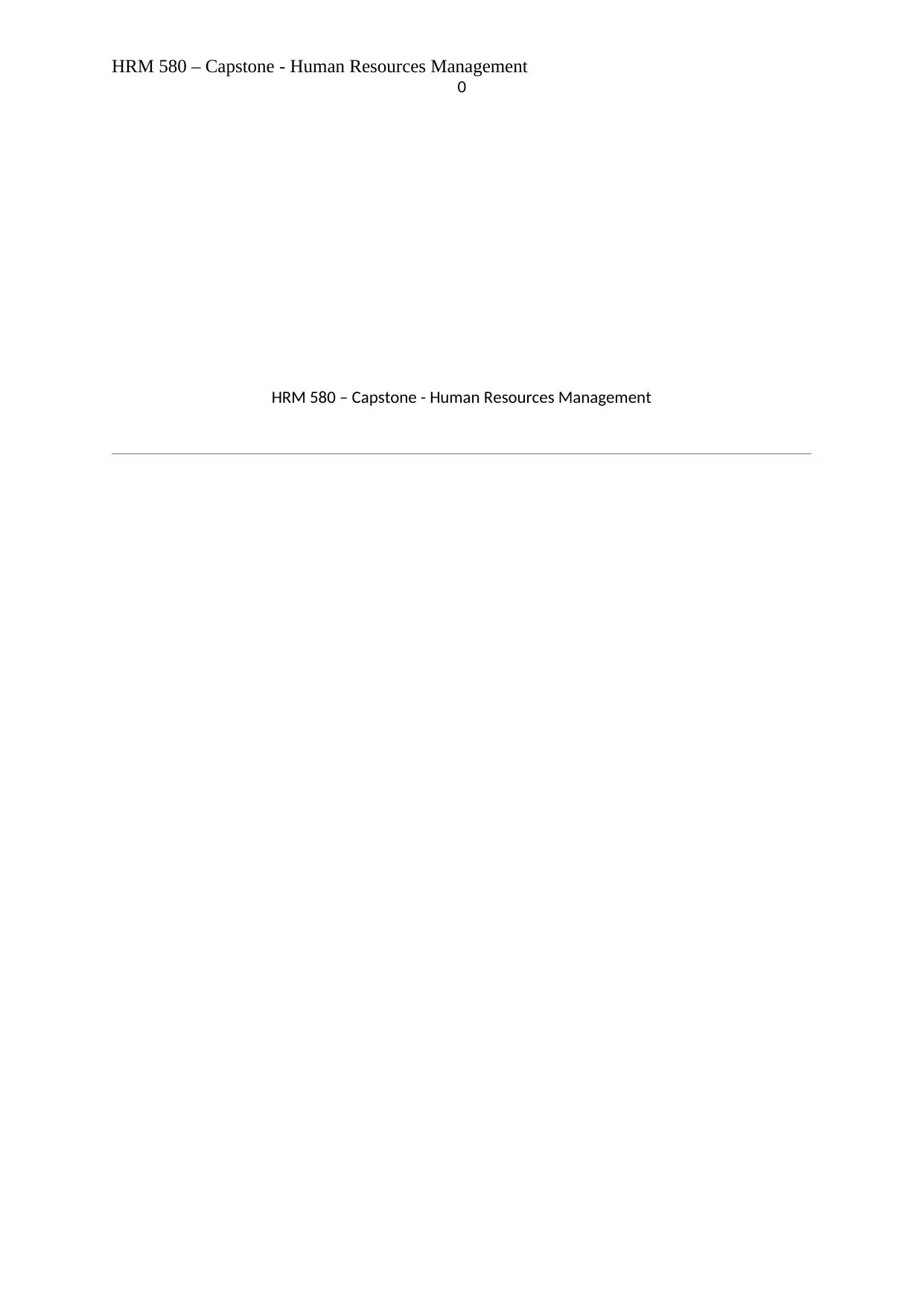
HRM 580 – Capstone - Human Resources Management
0
HRM 580 – Capstone - Human Resources Management
0
HRM 580 – Capstone - Human Resources Management
Paraphrase This Document
Need a fresh take? Get an instant paraphrase of this document with our AI Paraphraser
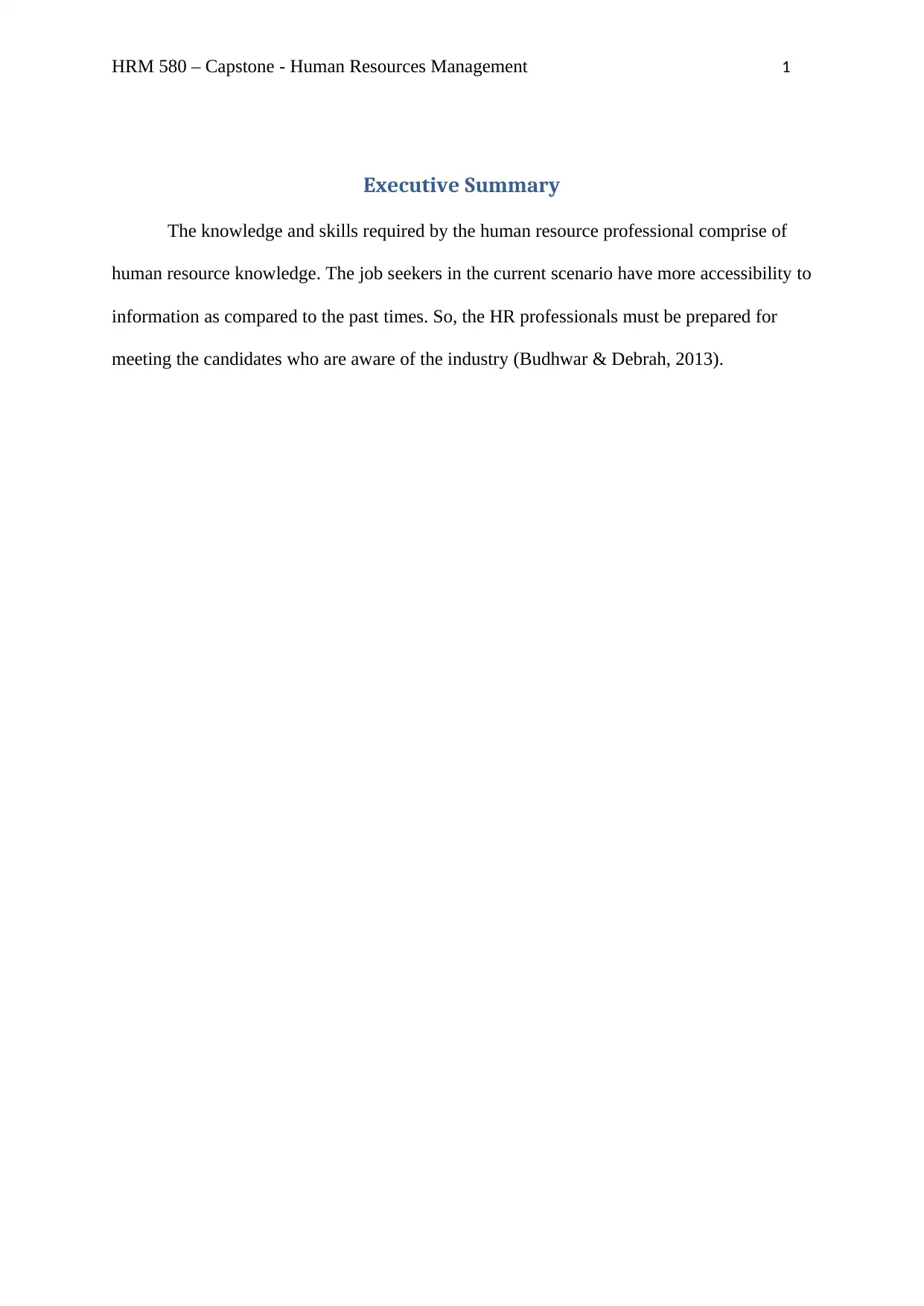
HRM 580 – Capstone - Human Resources Management 1
Executive Summary
The knowledge and skills required by the human resource professional comprise of
human resource knowledge. The job seekers in the current scenario have more accessibility to
information as compared to the past times. So, the HR professionals must be prepared for
meeting the candidates who are aware of the industry (Budhwar & Debrah, 2013).
Executive Summary
The knowledge and skills required by the human resource professional comprise of
human resource knowledge. The job seekers in the current scenario have more accessibility to
information as compared to the past times. So, the HR professionals must be prepared for
meeting the candidates who are aware of the industry (Budhwar & Debrah, 2013).
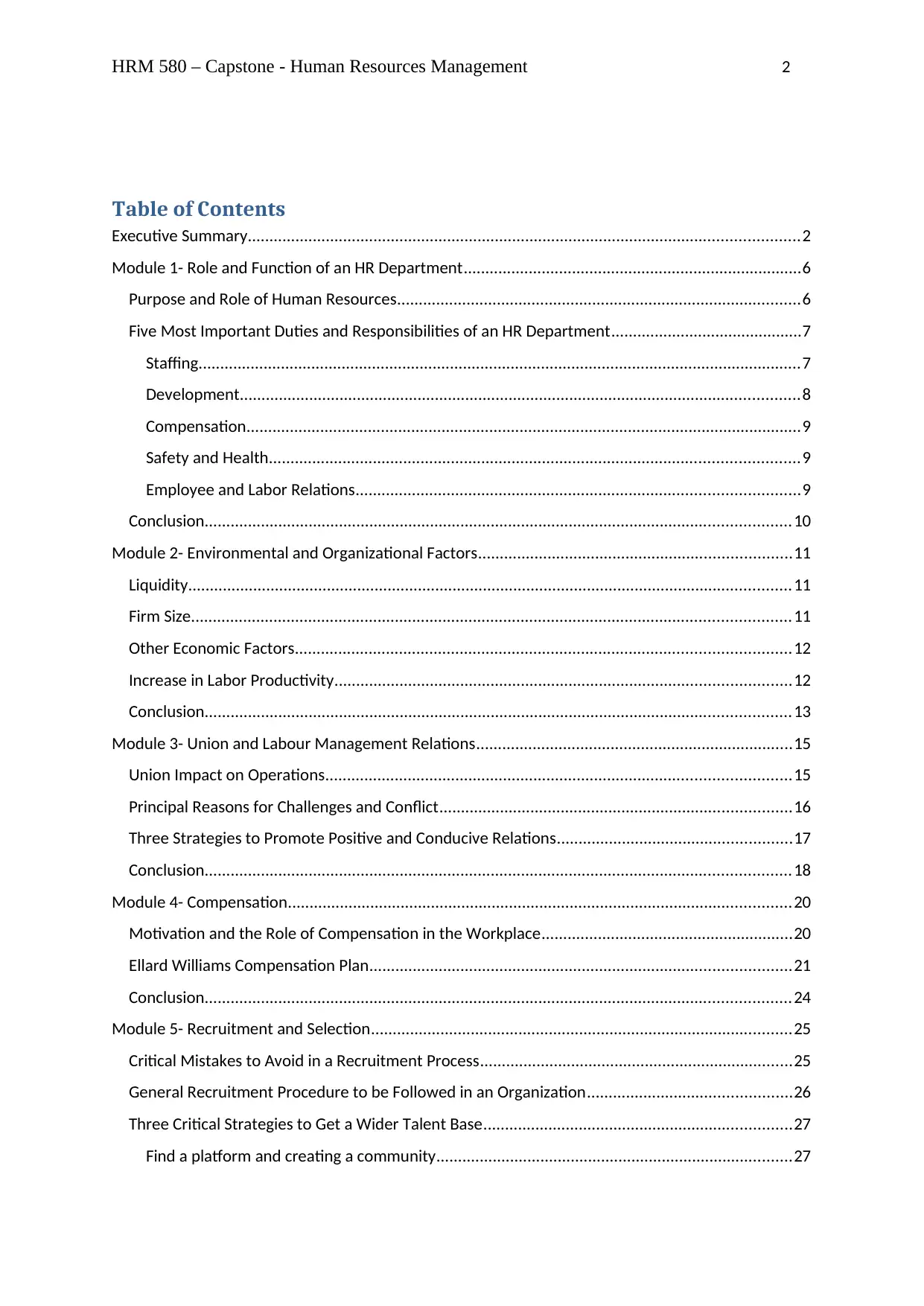
HRM 580 – Capstone - Human Resources Management 2
Table of Contents
Executive Summary...............................................................................................................................2
Module 1- Role and Function of an HR Department..............................................................................6
Purpose and Role of Human Resources.............................................................................................6
Five Most Important Duties and Responsibilities of an HR Department............................................7
Staffing...........................................................................................................................................7
Development.................................................................................................................................8
Compensation................................................................................................................................9
Safety and Health..........................................................................................................................9
Employee and Labor Relations......................................................................................................9
Conclusion.......................................................................................................................................10
Module 2- Environmental and Organizational Factors........................................................................11
Liquidity...........................................................................................................................................11
Firm Size..........................................................................................................................................11
Other Economic Factors..................................................................................................................12
Increase in Labor Productivity.........................................................................................................12
Conclusion.......................................................................................................................................13
Module 3- Union and Labour Management Relations.........................................................................15
Union Impact on Operations...........................................................................................................15
Principal Reasons for Challenges and Conflict.................................................................................16
Three Strategies to Promote Positive and Conducive Relations......................................................17
Conclusion.......................................................................................................................................18
Module 4- Compensation....................................................................................................................20
Motivation and the Role of Compensation in the Workplace..........................................................20
Ellard Williams Compensation Plan.................................................................................................21
Conclusion.......................................................................................................................................24
Module 5- Recruitment and Selection.................................................................................................25
Critical Mistakes to Avoid in a Recruitment Process........................................................................25
General Recruitment Procedure to be Followed in an Organization...............................................26
Three Critical Strategies to Get a Wider Talent Base.......................................................................27
Find a platform and creating a community..................................................................................27
Table of Contents
Executive Summary...............................................................................................................................2
Module 1- Role and Function of an HR Department..............................................................................6
Purpose and Role of Human Resources.............................................................................................6
Five Most Important Duties and Responsibilities of an HR Department............................................7
Staffing...........................................................................................................................................7
Development.................................................................................................................................8
Compensation................................................................................................................................9
Safety and Health..........................................................................................................................9
Employee and Labor Relations......................................................................................................9
Conclusion.......................................................................................................................................10
Module 2- Environmental and Organizational Factors........................................................................11
Liquidity...........................................................................................................................................11
Firm Size..........................................................................................................................................11
Other Economic Factors..................................................................................................................12
Increase in Labor Productivity.........................................................................................................12
Conclusion.......................................................................................................................................13
Module 3- Union and Labour Management Relations.........................................................................15
Union Impact on Operations...........................................................................................................15
Principal Reasons for Challenges and Conflict.................................................................................16
Three Strategies to Promote Positive and Conducive Relations......................................................17
Conclusion.......................................................................................................................................18
Module 4- Compensation....................................................................................................................20
Motivation and the Role of Compensation in the Workplace..........................................................20
Ellard Williams Compensation Plan.................................................................................................21
Conclusion.......................................................................................................................................24
Module 5- Recruitment and Selection.................................................................................................25
Critical Mistakes to Avoid in a Recruitment Process........................................................................25
General Recruitment Procedure to be Followed in an Organization...............................................26
Three Critical Strategies to Get a Wider Talent Base.......................................................................27
Find a platform and creating a community..................................................................................27
⊘ This is a preview!⊘
Do you want full access?
Subscribe today to unlock all pages.

Trusted by 1+ million students worldwide
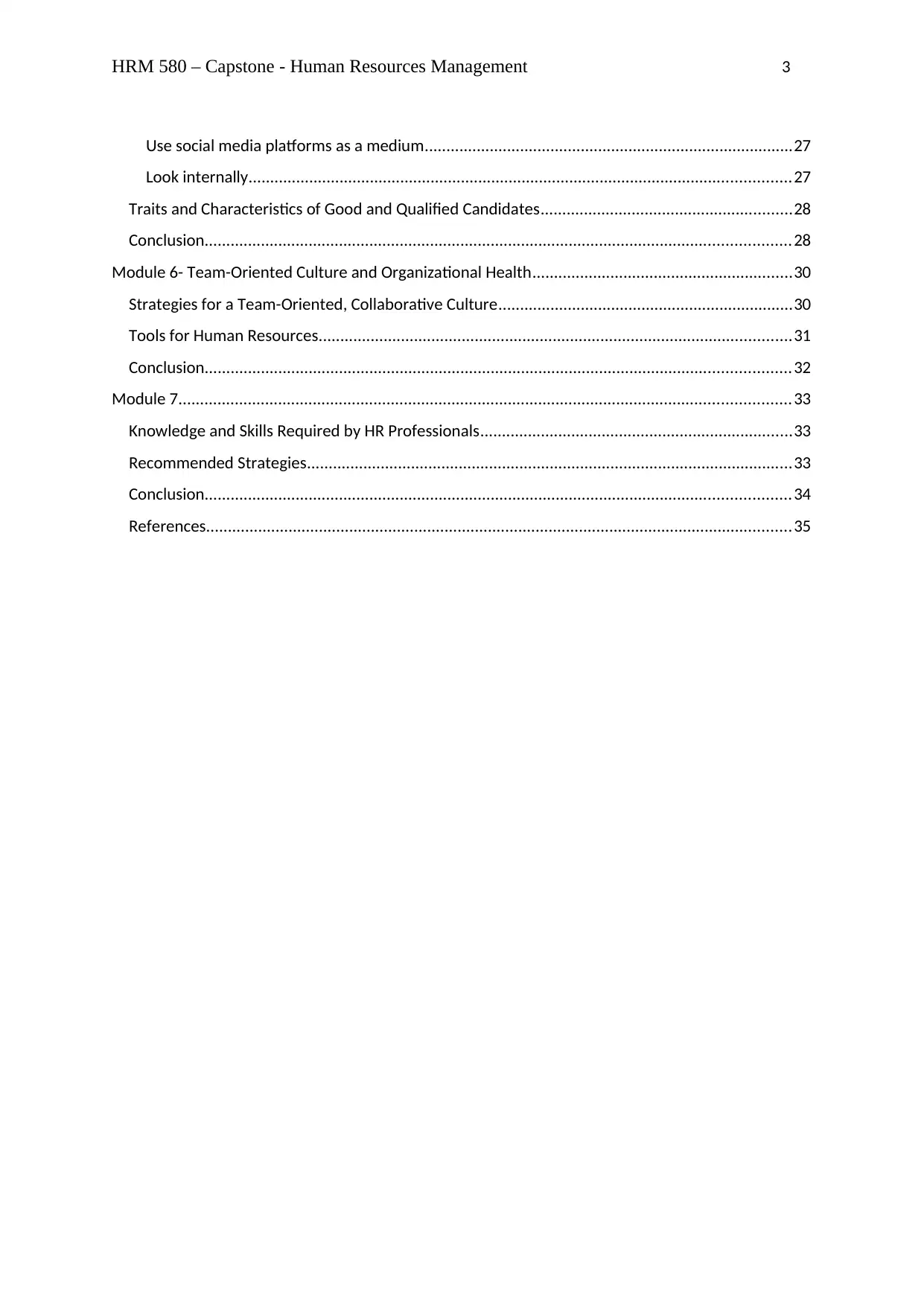
HRM 580 – Capstone - Human Resources Management 3
Use social media platforms as a medium.....................................................................................27
Look internally.............................................................................................................................27
Traits and Characteristics of Good and Qualified Candidates..........................................................28
Conclusion.......................................................................................................................................28
Module 6- Team-Oriented Culture and Organizational Health............................................................30
Strategies for a Team-Oriented, Collaborative Culture....................................................................30
Tools for Human Resources.............................................................................................................31
Conclusion.......................................................................................................................................32
Module 7.............................................................................................................................................33
Knowledge and Skills Required by HR Professionals........................................................................33
Recommended Strategies................................................................................................................33
Conclusion.......................................................................................................................................34
References.......................................................................................................................................35
Use social media platforms as a medium.....................................................................................27
Look internally.............................................................................................................................27
Traits and Characteristics of Good and Qualified Candidates..........................................................28
Conclusion.......................................................................................................................................28
Module 6- Team-Oriented Culture and Organizational Health............................................................30
Strategies for a Team-Oriented, Collaborative Culture....................................................................30
Tools for Human Resources.............................................................................................................31
Conclusion.......................................................................................................................................32
Module 7.............................................................................................................................................33
Knowledge and Skills Required by HR Professionals........................................................................33
Recommended Strategies................................................................................................................33
Conclusion.......................................................................................................................................34
References.......................................................................................................................................35
Paraphrase This Document
Need a fresh take? Get an instant paraphrase of this document with our AI Paraphraser
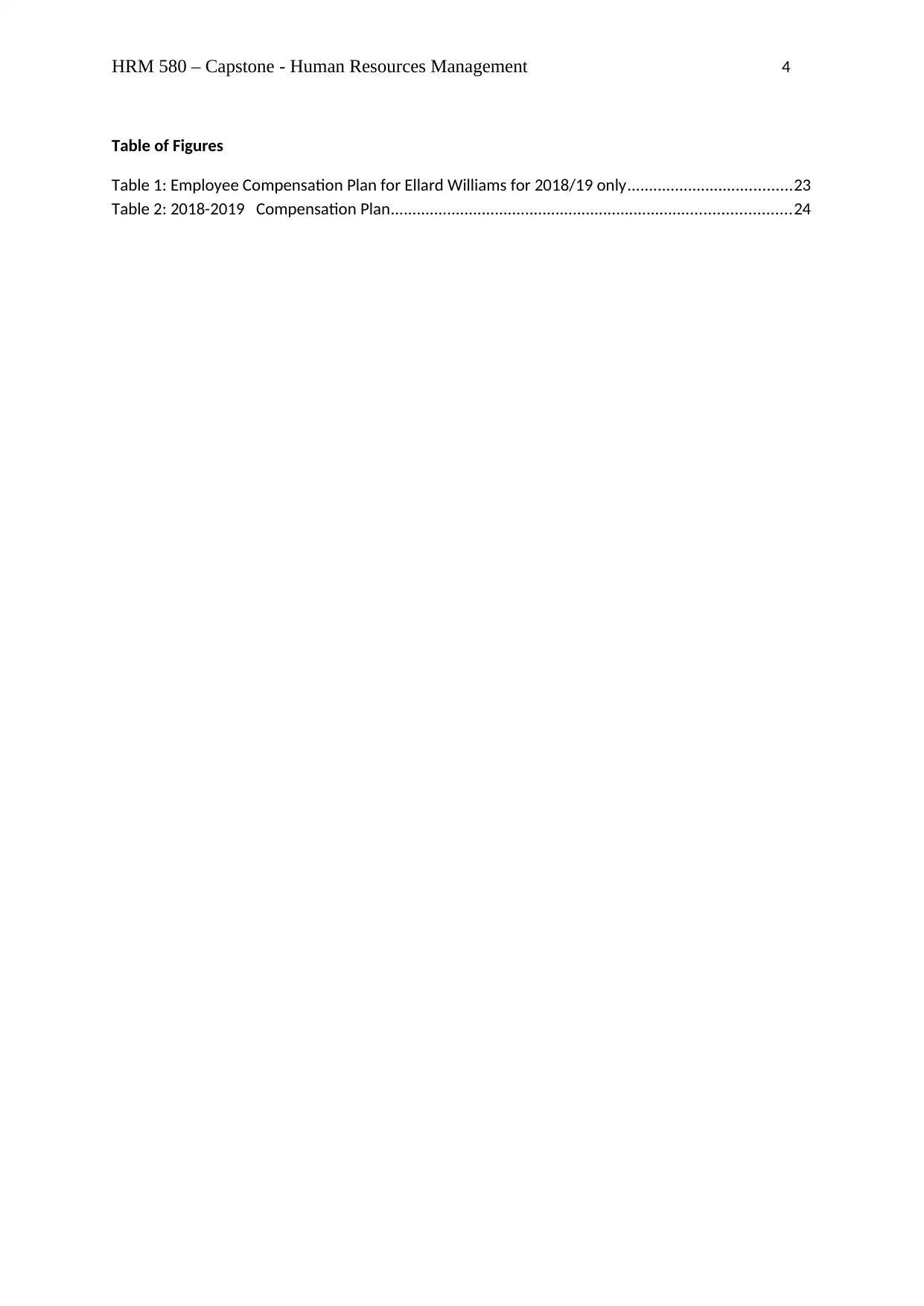
HRM 580 – Capstone - Human Resources Management 4
Table of Figures
Table 1: Employee Compensation Plan for Ellard Williams for 2018/19 only......................................23
Table 2: 2018-2019 Compensation Plan............................................................................................24
Table of Figures
Table 1: Employee Compensation Plan for Ellard Williams for 2018/19 only......................................23
Table 2: 2018-2019 Compensation Plan............................................................................................24
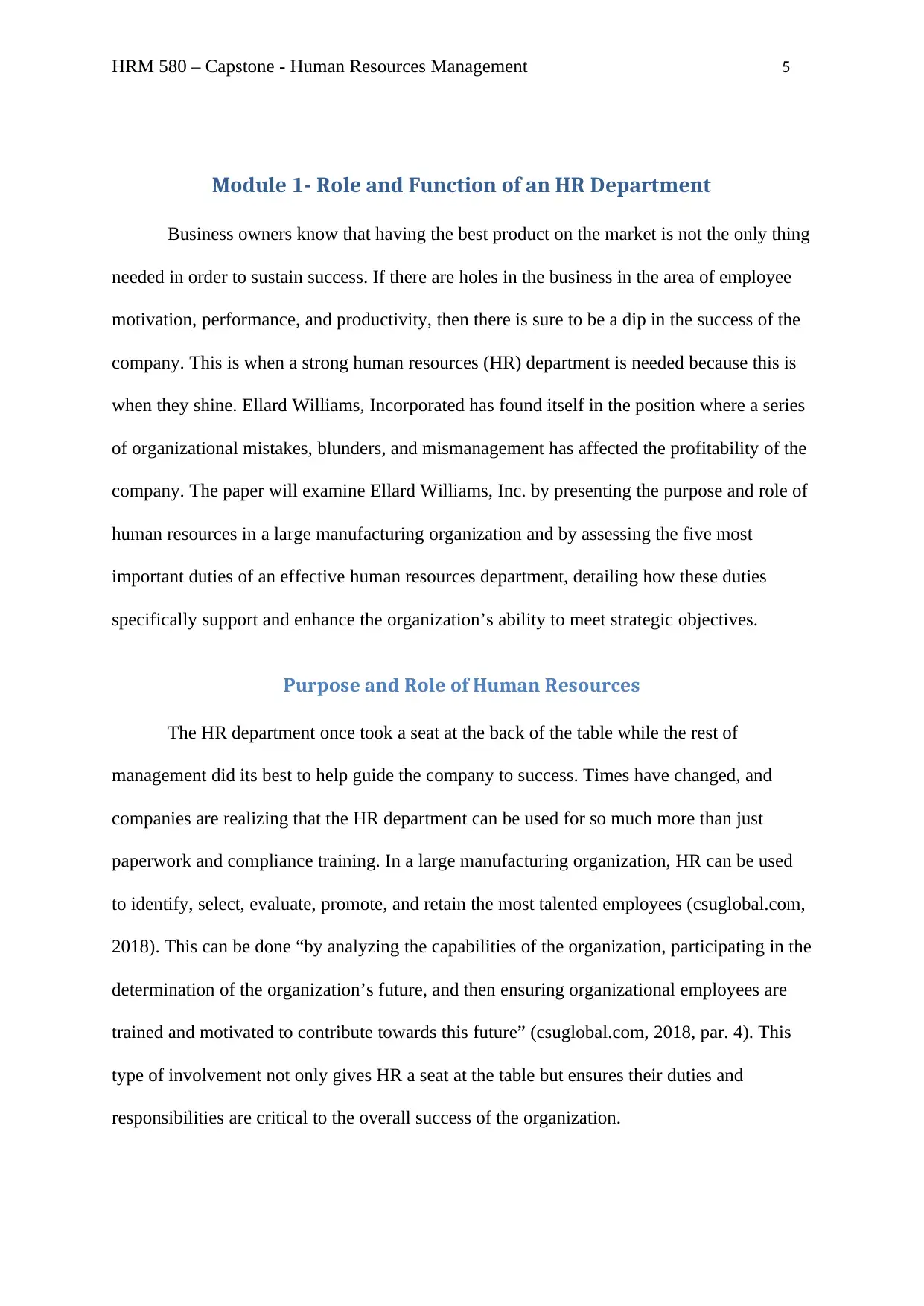
HRM 580 – Capstone - Human Resources Management 5
Module 1- Role and Function of an HR Department
Business owners know that having the best product on the market is not the only thing
needed in order to sustain success. If there are holes in the business in the area of employee
motivation, performance, and productivity, then there is sure to be a dip in the success of the
company. This is when a strong human resources (HR) department is needed because this is
when they shine. Ellard Williams, Incorporated has found itself in the position where a series
of organizational mistakes, blunders, and mismanagement has affected the profitability of the
company. The paper will examine Ellard Williams, Inc. by presenting the purpose and role of
human resources in a large manufacturing organization and by assessing the five most
important duties of an effective human resources department, detailing how these duties
specifically support and enhance the organization’s ability to meet strategic objectives.
Purpose and Role of Human Resources
The HR department once took a seat at the back of the table while the rest of
management did its best to help guide the company to success. Times have changed, and
companies are realizing that the HR department can be used for so much more than just
paperwork and compliance training. In a large manufacturing organization, HR can be used
to identify, select, evaluate, promote, and retain the most talented employees (csuglobal.com,
2018). This can be done “by analyzing the capabilities of the organization, participating in the
determination of the organization’s future, and then ensuring organizational employees are
trained and motivated to contribute towards this future” (csuglobal.com, 2018, par. 4). This
type of involvement not only gives HR a seat at the table but ensures their duties and
responsibilities are critical to the overall success of the organization.
Module 1- Role and Function of an HR Department
Business owners know that having the best product on the market is not the only thing
needed in order to sustain success. If there are holes in the business in the area of employee
motivation, performance, and productivity, then there is sure to be a dip in the success of the
company. This is when a strong human resources (HR) department is needed because this is
when they shine. Ellard Williams, Incorporated has found itself in the position where a series
of organizational mistakes, blunders, and mismanagement has affected the profitability of the
company. The paper will examine Ellard Williams, Inc. by presenting the purpose and role of
human resources in a large manufacturing organization and by assessing the five most
important duties of an effective human resources department, detailing how these duties
specifically support and enhance the organization’s ability to meet strategic objectives.
Purpose and Role of Human Resources
The HR department once took a seat at the back of the table while the rest of
management did its best to help guide the company to success. Times have changed, and
companies are realizing that the HR department can be used for so much more than just
paperwork and compliance training. In a large manufacturing organization, HR can be used
to identify, select, evaluate, promote, and retain the most talented employees (csuglobal.com,
2018). This can be done “by analyzing the capabilities of the organization, participating in the
determination of the organization’s future, and then ensuring organizational employees are
trained and motivated to contribute towards this future” (csuglobal.com, 2018, par. 4). This
type of involvement not only gives HR a seat at the table but ensures their duties and
responsibilities are critical to the overall success of the organization.
⊘ This is a preview!⊘
Do you want full access?
Subscribe today to unlock all pages.

Trusted by 1+ million students worldwide
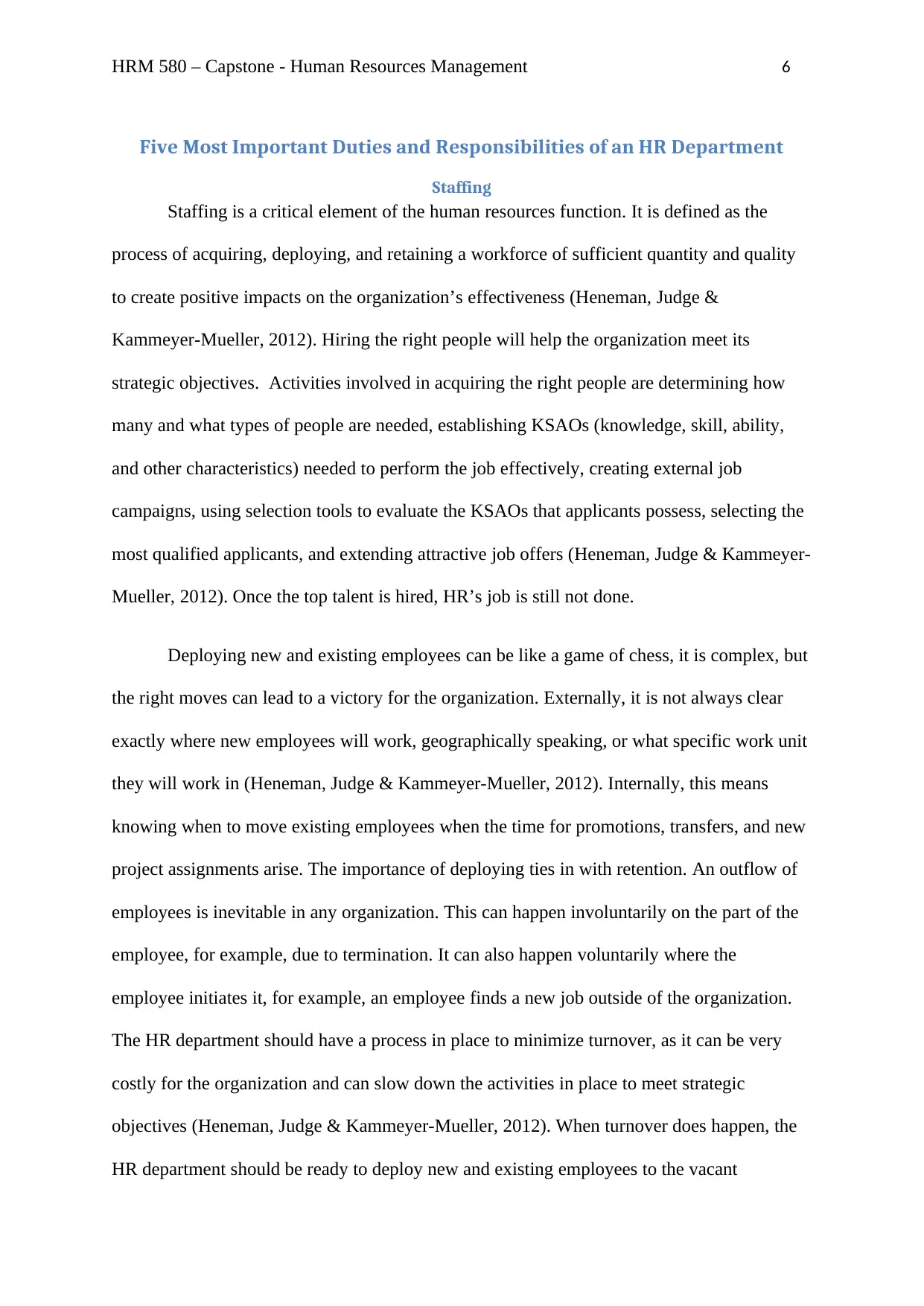
HRM 580 – Capstone - Human Resources Management 6
Five Most Important Duties and Responsibilities of an HR Department
Staffing
Staffing is a critical element of the human resources function. It is defined as the
process of acquiring, deploying, and retaining a workforce of sufficient quantity and quality
to create positive impacts on the organization’s effectiveness (Heneman, Judge &
Kammeyer-Mueller, 2012). Hiring the right people will help the organization meet its
strategic objectives. Activities involved in acquiring the right people are determining how
many and what types of people are needed, establishing KSAOs (knowledge, skill, ability,
and other characteristics) needed to perform the job effectively, creating external job
campaigns, using selection tools to evaluate the KSAOs that applicants possess, selecting the
most qualified applicants, and extending attractive job offers (Heneman, Judge & Kammeyer-
Mueller, 2012). Once the top talent is hired, HR’s job is still not done.
Deploying new and existing employees can be like a game of chess, it is complex, but
the right moves can lead to a victory for the organization. Externally, it is not always clear
exactly where new employees will work, geographically speaking, or what specific work unit
they will work in (Heneman, Judge & Kammeyer-Mueller, 2012). Internally, this means
knowing when to move existing employees when the time for promotions, transfers, and new
project assignments arise. The importance of deploying ties in with retention. An outflow of
employees is inevitable in any organization. This can happen involuntarily on the part of the
employee, for example, due to termination. It can also happen voluntarily where the
employee initiates it, for example, an employee finds a new job outside of the organization.
The HR department should have a process in place to minimize turnover, as it can be very
costly for the organization and can slow down the activities in place to meet strategic
objectives (Heneman, Judge & Kammeyer-Mueller, 2012). When turnover does happen, the
HR department should be ready to deploy new and existing employees to the vacant
Five Most Important Duties and Responsibilities of an HR Department
Staffing
Staffing is a critical element of the human resources function. It is defined as the
process of acquiring, deploying, and retaining a workforce of sufficient quantity and quality
to create positive impacts on the organization’s effectiveness (Heneman, Judge &
Kammeyer-Mueller, 2012). Hiring the right people will help the organization meet its
strategic objectives. Activities involved in acquiring the right people are determining how
many and what types of people are needed, establishing KSAOs (knowledge, skill, ability,
and other characteristics) needed to perform the job effectively, creating external job
campaigns, using selection tools to evaluate the KSAOs that applicants possess, selecting the
most qualified applicants, and extending attractive job offers (Heneman, Judge & Kammeyer-
Mueller, 2012). Once the top talent is hired, HR’s job is still not done.
Deploying new and existing employees can be like a game of chess, it is complex, but
the right moves can lead to a victory for the organization. Externally, it is not always clear
exactly where new employees will work, geographically speaking, or what specific work unit
they will work in (Heneman, Judge & Kammeyer-Mueller, 2012). Internally, this means
knowing when to move existing employees when the time for promotions, transfers, and new
project assignments arise. The importance of deploying ties in with retention. An outflow of
employees is inevitable in any organization. This can happen involuntarily on the part of the
employee, for example, due to termination. It can also happen voluntarily where the
employee initiates it, for example, an employee finds a new job outside of the organization.
The HR department should have a process in place to minimize turnover, as it can be very
costly for the organization and can slow down the activities in place to meet strategic
objectives (Heneman, Judge & Kammeyer-Mueller, 2012). When turnover does happen, the
HR department should be ready to deploy new and existing employees to the vacant
Paraphrase This Document
Need a fresh take? Get an instant paraphrase of this document with our AI Paraphraser
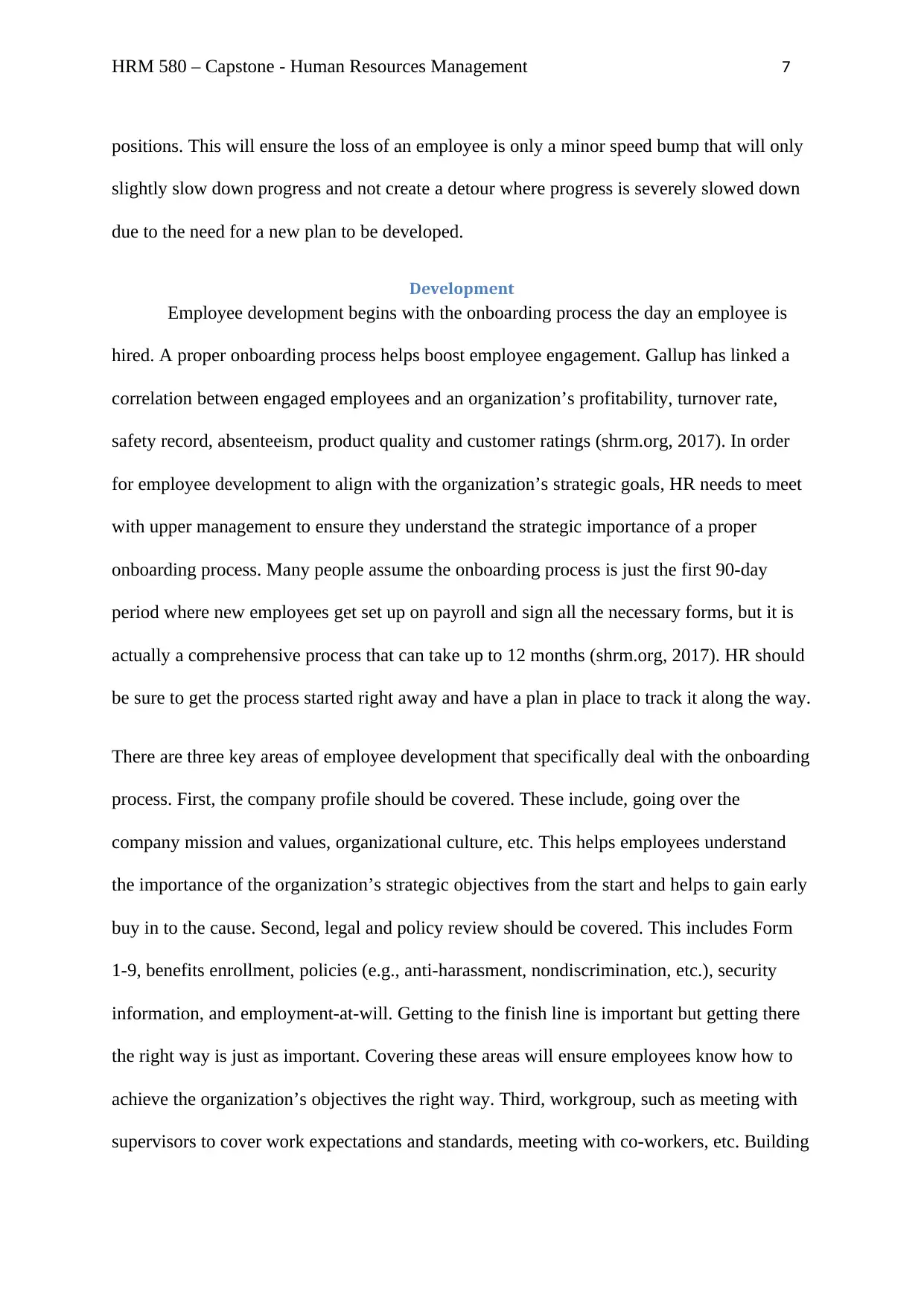
HRM 580 – Capstone - Human Resources Management 7
positions. This will ensure the loss of an employee is only a minor speed bump that will only
slightly slow down progress and not create a detour where progress is severely slowed down
due to the need for a new plan to be developed.
Development
Employee development begins with the onboarding process the day an employee is
hired. A proper onboarding process helps boost employee engagement. Gallup has linked a
correlation between engaged employees and an organization’s profitability, turnover rate,
safety record, absenteeism, product quality and customer ratings (shrm.org, 2017). In order
for employee development to align with the organization’s strategic goals, HR needs to meet
with upper management to ensure they understand the strategic importance of a proper
onboarding process. Many people assume the onboarding process is just the first 90-day
period where new employees get set up on payroll and sign all the necessary forms, but it is
actually a comprehensive process that can take up to 12 months (shrm.org, 2017). HR should
be sure to get the process started right away and have a plan in place to track it along the way.
There are three key areas of employee development that specifically deal with the onboarding
process. First, the company profile should be covered. These include, going over the
company mission and values, organizational culture, etc. This helps employees understand
the importance of the organization’s strategic objectives from the start and helps to gain early
buy in to the cause. Second, legal and policy review should be covered. This includes Form
1-9, benefits enrollment, policies (e.g., anti-harassment, nondiscrimination, etc.), security
information, and employment-at-will. Getting to the finish line is important but getting there
the right way is just as important. Covering these areas will ensure employees know how to
achieve the organization’s objectives the right way. Third, workgroup, such as meeting with
supervisors to cover work expectations and standards, meeting with co-workers, etc. Building
positions. This will ensure the loss of an employee is only a minor speed bump that will only
slightly slow down progress and not create a detour where progress is severely slowed down
due to the need for a new plan to be developed.
Development
Employee development begins with the onboarding process the day an employee is
hired. A proper onboarding process helps boost employee engagement. Gallup has linked a
correlation between engaged employees and an organization’s profitability, turnover rate,
safety record, absenteeism, product quality and customer ratings (shrm.org, 2017). In order
for employee development to align with the organization’s strategic goals, HR needs to meet
with upper management to ensure they understand the strategic importance of a proper
onboarding process. Many people assume the onboarding process is just the first 90-day
period where new employees get set up on payroll and sign all the necessary forms, but it is
actually a comprehensive process that can take up to 12 months (shrm.org, 2017). HR should
be sure to get the process started right away and have a plan in place to track it along the way.
There are three key areas of employee development that specifically deal with the onboarding
process. First, the company profile should be covered. These include, going over the
company mission and values, organizational culture, etc. This helps employees understand
the importance of the organization’s strategic objectives from the start and helps to gain early
buy in to the cause. Second, legal and policy review should be covered. This includes Form
1-9, benefits enrollment, policies (e.g., anti-harassment, nondiscrimination, etc.), security
information, and employment-at-will. Getting to the finish line is important but getting there
the right way is just as important. Covering these areas will ensure employees know how to
achieve the organization’s objectives the right way. Third, workgroup, such as meeting with
supervisors to cover work expectations and standards, meeting with co-workers, etc. Building
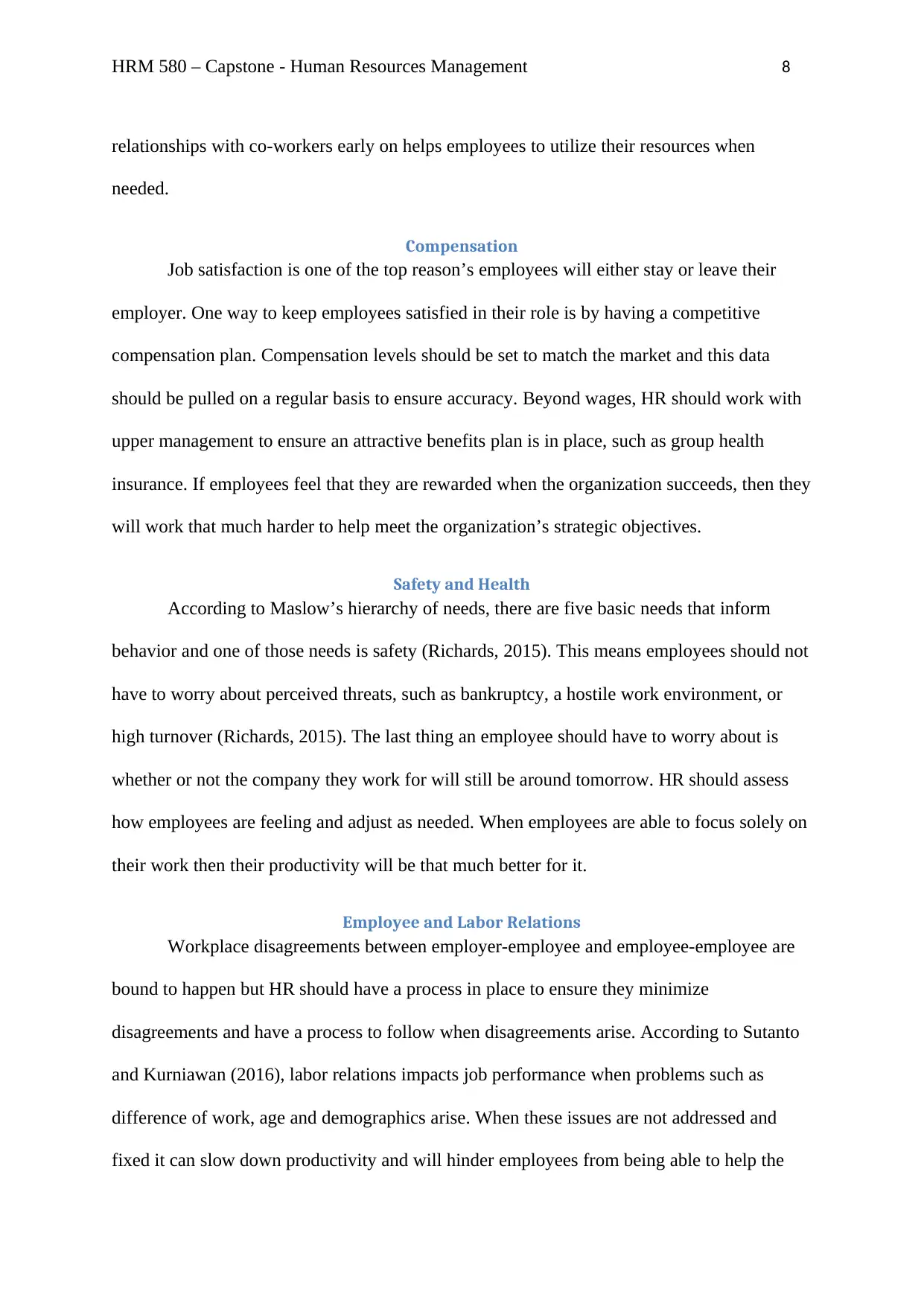
HRM 580 – Capstone - Human Resources Management 8
relationships with co-workers early on helps employees to utilize their resources when
needed.
Compensation
Job satisfaction is one of the top reason’s employees will either stay or leave their
employer. One way to keep employees satisfied in their role is by having a competitive
compensation plan. Compensation levels should be set to match the market and this data
should be pulled on a regular basis to ensure accuracy. Beyond wages, HR should work with
upper management to ensure an attractive benefits plan is in place, such as group health
insurance. If employees feel that they are rewarded when the organization succeeds, then they
will work that much harder to help meet the organization’s strategic objectives.
Safety and Health
According to Maslow’s hierarchy of needs, there are five basic needs that inform
behavior and one of those needs is safety (Richards, 2015). This means employees should not
have to worry about perceived threats, such as bankruptcy, a hostile work environment, or
high turnover (Richards, 2015). The last thing an employee should have to worry about is
whether or not the company they work for will still be around tomorrow. HR should assess
how employees are feeling and adjust as needed. When employees are able to focus solely on
their work then their productivity will be that much better for it.
Employee and Labor Relations
Workplace disagreements between employer-employee and employee-employee are
bound to happen but HR should have a process in place to ensure they minimize
disagreements and have a process to follow when disagreements arise. According to Sutanto
and Kurniawan (2016), labor relations impacts job performance when problems such as
difference of work, age and demographics arise. When these issues are not addressed and
fixed it can slow down productivity and will hinder employees from being able to help the
relationships with co-workers early on helps employees to utilize their resources when
needed.
Compensation
Job satisfaction is one of the top reason’s employees will either stay or leave their
employer. One way to keep employees satisfied in their role is by having a competitive
compensation plan. Compensation levels should be set to match the market and this data
should be pulled on a regular basis to ensure accuracy. Beyond wages, HR should work with
upper management to ensure an attractive benefits plan is in place, such as group health
insurance. If employees feel that they are rewarded when the organization succeeds, then they
will work that much harder to help meet the organization’s strategic objectives.
Safety and Health
According to Maslow’s hierarchy of needs, there are five basic needs that inform
behavior and one of those needs is safety (Richards, 2015). This means employees should not
have to worry about perceived threats, such as bankruptcy, a hostile work environment, or
high turnover (Richards, 2015). The last thing an employee should have to worry about is
whether or not the company they work for will still be around tomorrow. HR should assess
how employees are feeling and adjust as needed. When employees are able to focus solely on
their work then their productivity will be that much better for it.
Employee and Labor Relations
Workplace disagreements between employer-employee and employee-employee are
bound to happen but HR should have a process in place to ensure they minimize
disagreements and have a process to follow when disagreements arise. According to Sutanto
and Kurniawan (2016), labor relations impacts job performance when problems such as
difference of work, age and demographics arise. When these issues are not addressed and
fixed it can slow down productivity and will hinder employees from being able to help the
⊘ This is a preview!⊘
Do you want full access?
Subscribe today to unlock all pages.

Trusted by 1+ million students worldwide
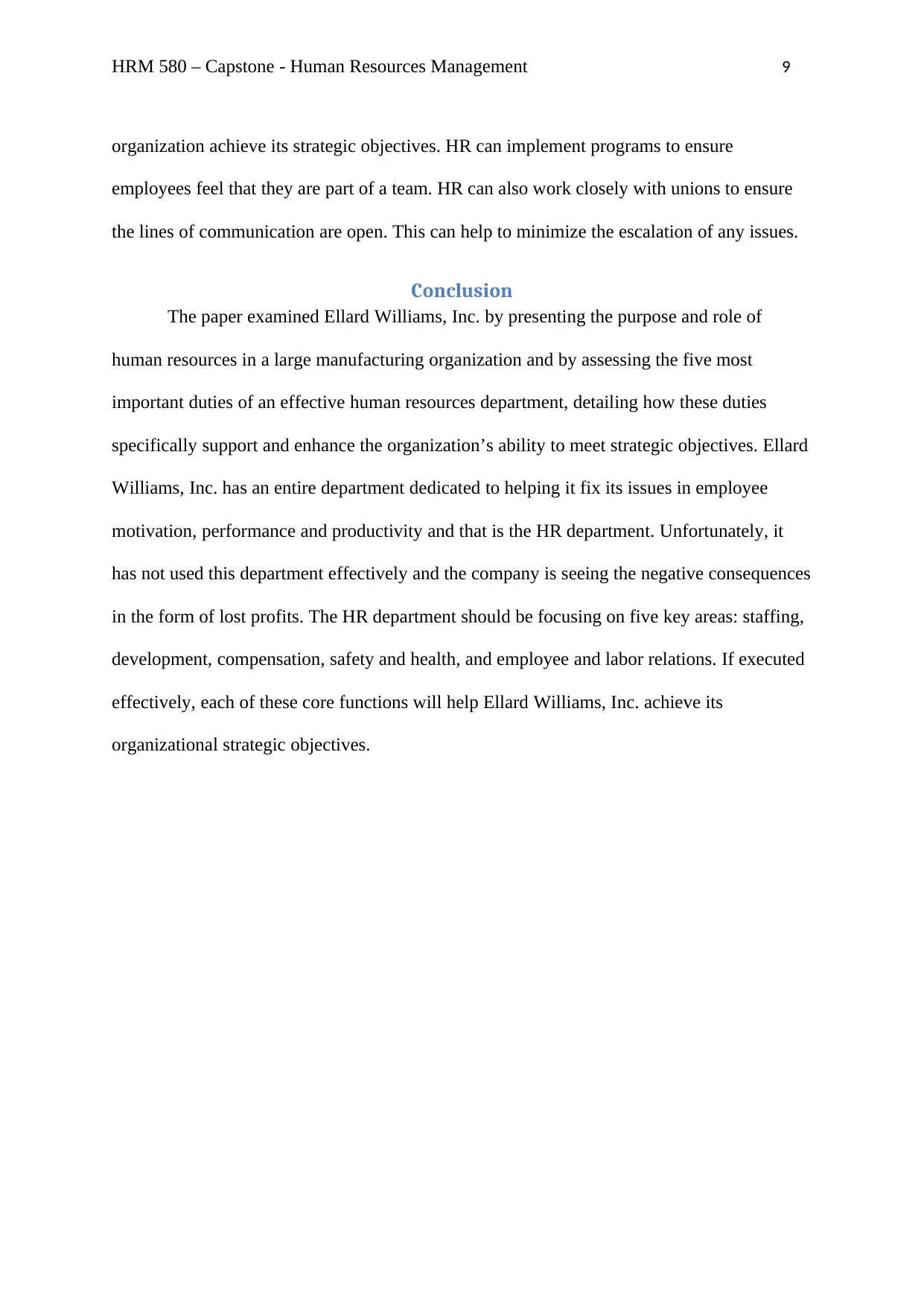
HRM 580 – Capstone - Human Resources Management 9
organization achieve its strategic objectives. HR can implement programs to ensure
employees feel that they are part of a team. HR can also work closely with unions to ensure
the lines of communication are open. This can help to minimize the escalation of any issues.
Conclusion
The paper examined Ellard Williams, Inc. by presenting the purpose and role of
human resources in a large manufacturing organization and by assessing the five most
important duties of an effective human resources department, detailing how these duties
specifically support and enhance the organization’s ability to meet strategic objectives. Ellard
Williams, Inc. has an entire department dedicated to helping it fix its issues in employee
motivation, performance and productivity and that is the HR department. Unfortunately, it
has not used this department effectively and the company is seeing the negative consequences
in the form of lost profits. The HR department should be focusing on five key areas: staffing,
development, compensation, safety and health, and employee and labor relations. If executed
effectively, each of these core functions will help Ellard Williams, Inc. achieve its
organizational strategic objectives.
organization achieve its strategic objectives. HR can implement programs to ensure
employees feel that they are part of a team. HR can also work closely with unions to ensure
the lines of communication are open. This can help to minimize the escalation of any issues.
Conclusion
The paper examined Ellard Williams, Inc. by presenting the purpose and role of
human resources in a large manufacturing organization and by assessing the five most
important duties of an effective human resources department, detailing how these duties
specifically support and enhance the organization’s ability to meet strategic objectives. Ellard
Williams, Inc. has an entire department dedicated to helping it fix its issues in employee
motivation, performance and productivity and that is the HR department. Unfortunately, it
has not used this department effectively and the company is seeing the negative consequences
in the form of lost profits. The HR department should be focusing on five key areas: staffing,
development, compensation, safety and health, and employee and labor relations. If executed
effectively, each of these core functions will help Ellard Williams, Inc. achieve its
organizational strategic objectives.
Paraphrase This Document
Need a fresh take? Get an instant paraphrase of this document with our AI Paraphraser
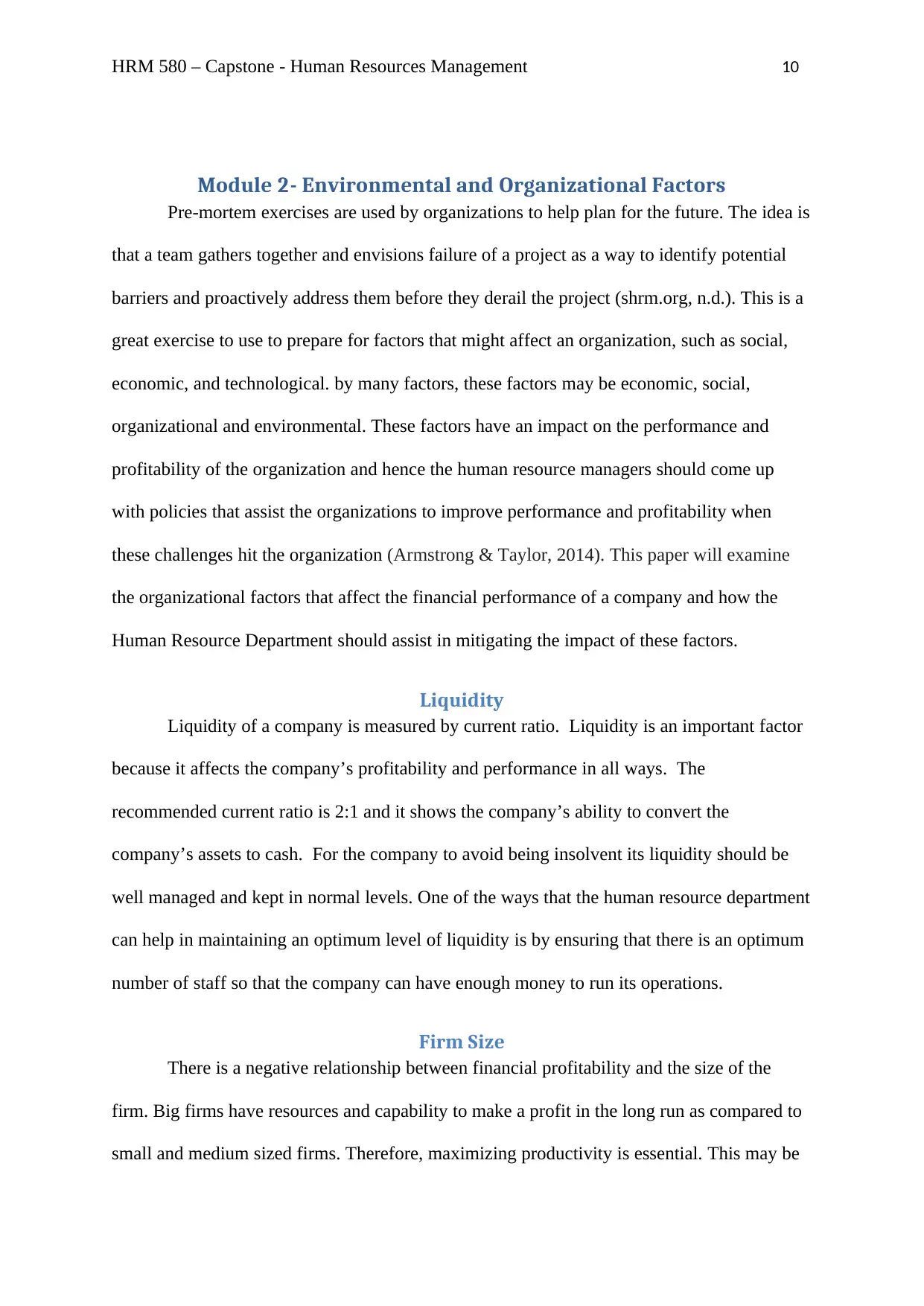
HRM 580 – Capstone - Human Resources Management 10
Module 2- Environmental and Organizational Factors
Pre-mortem exercises are used by organizations to help plan for the future. The idea is
that a team gathers together and envisions failure of a project as a way to identify potential
barriers and proactively address them before they derail the project (shrm.org, n.d.). This is a
great exercise to use to prepare for factors that might affect an organization, such as social,
economic, and technological. by many factors, these factors may be economic, social,
organizational and environmental. These factors have an impact on the performance and
profitability of the organization and hence the human resource managers should come up
with policies that assist the organizations to improve performance and profitability when
these challenges hit the organization (Armstrong & Taylor, 2014). This paper will examine
the organizational factors that affect the financial performance of a company and how the
Human Resource Department should assist in mitigating the impact of these factors.
Liquidity
Liquidity of a company is measured by current ratio. Liquidity is an important factor
because it affects the company’s profitability and performance in all ways. The
recommended current ratio is 2:1 and it shows the company’s ability to convert the
company’s assets to cash. For the company to avoid being insolvent its liquidity should be
well managed and kept in normal levels. One of the ways that the human resource department
can help in maintaining an optimum level of liquidity is by ensuring that there is an optimum
number of staff so that the company can have enough money to run its operations.
Firm Size
There is a negative relationship between financial profitability and the size of the
firm. Big firms have resources and capability to make a profit in the long run as compared to
small and medium sized firms. Therefore, maximizing productivity is essential. This may be
Module 2- Environmental and Organizational Factors
Pre-mortem exercises are used by organizations to help plan for the future. The idea is
that a team gathers together and envisions failure of a project as a way to identify potential
barriers and proactively address them before they derail the project (shrm.org, n.d.). This is a
great exercise to use to prepare for factors that might affect an organization, such as social,
economic, and technological. by many factors, these factors may be economic, social,
organizational and environmental. These factors have an impact on the performance and
profitability of the organization and hence the human resource managers should come up
with policies that assist the organizations to improve performance and profitability when
these challenges hit the organization (Armstrong & Taylor, 2014). This paper will examine
the organizational factors that affect the financial performance of a company and how the
Human Resource Department should assist in mitigating the impact of these factors.
Liquidity
Liquidity of a company is measured by current ratio. Liquidity is an important factor
because it affects the company’s profitability and performance in all ways. The
recommended current ratio is 2:1 and it shows the company’s ability to convert the
company’s assets to cash. For the company to avoid being insolvent its liquidity should be
well managed and kept in normal levels. One of the ways that the human resource department
can help in maintaining an optimum level of liquidity is by ensuring that there is an optimum
number of staff so that the company can have enough money to run its operations.
Firm Size
There is a negative relationship between financial profitability and the size of the
firm. Big firms have resources and capability to make a profit in the long run as compared to
small and medium sized firms. Therefore, maximizing productivity is essential. This may be
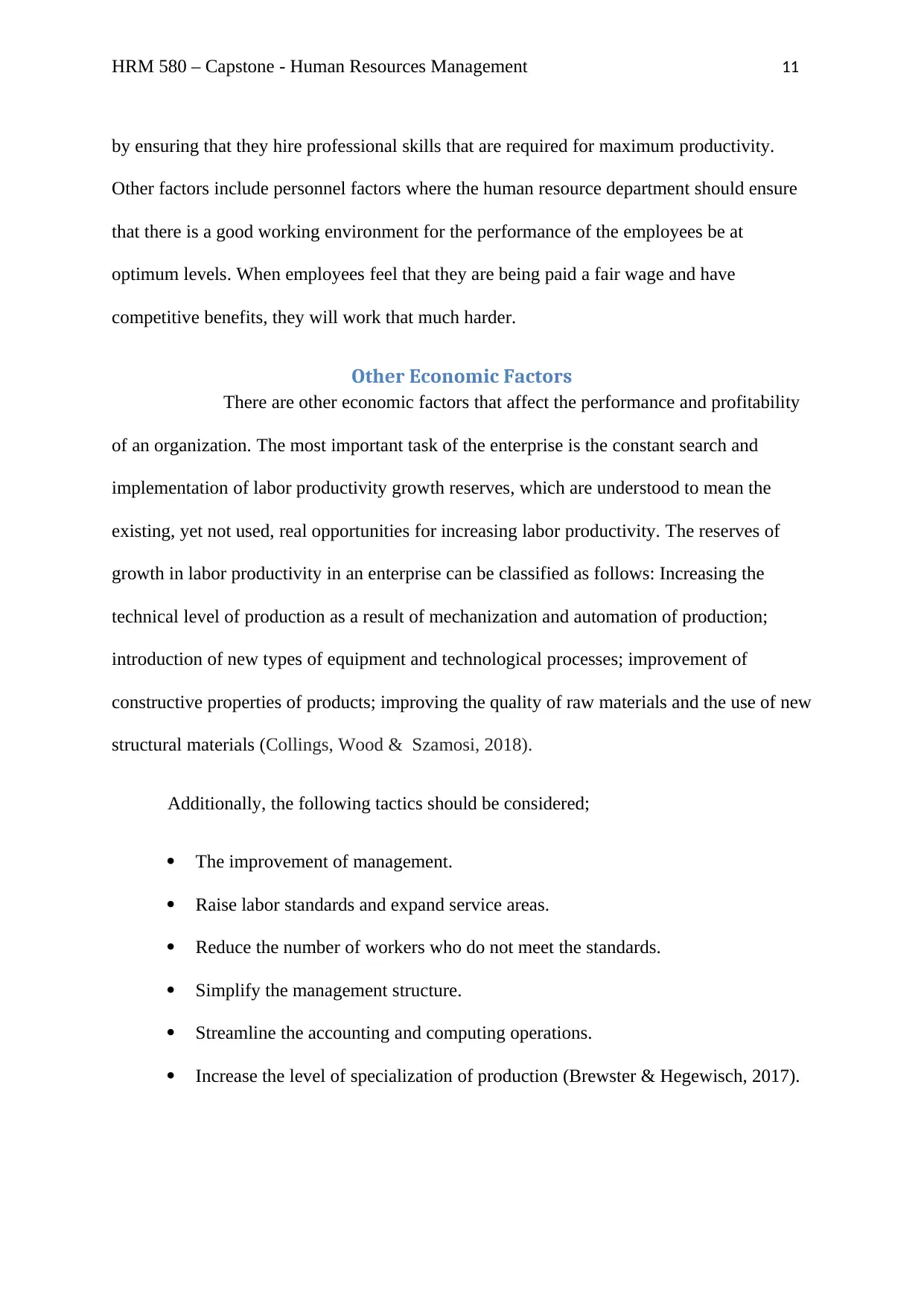
HRM 580 – Capstone - Human Resources Management 11
by ensuring that they hire professional skills that are required for maximum productivity.
Other factors include personnel factors where the human resource department should ensure
that there is a good working environment for the performance of the employees be at
optimum levels. When employees feel that they are being paid a fair wage and have
competitive benefits, they will work that much harder.
Other Economic Factors
There are other economic factors that affect the performance and profitability
of an organization. The most important task of the enterprise is the constant search and
implementation of labor productivity growth reserves, which are understood to mean the
existing, yet not used, real opportunities for increasing labor productivity. The reserves of
growth in labor productivity in an enterprise can be classified as follows: Increasing the
technical level of production as a result of mechanization and automation of production;
introduction of new types of equipment and technological processes; improvement of
constructive properties of products; improving the quality of raw materials and the use of new
structural materials (Collings, Wood & Szamosi, 2018).
Additionally, the following tactics should be considered;
The improvement of management.
Raise labor standards and expand service areas.
Reduce the number of workers who do not meet the standards.
Simplify the management structure.
Streamline the accounting and computing operations.
Increase the level of specialization of production (Brewster & Hegewisch, 2017).
by ensuring that they hire professional skills that are required for maximum productivity.
Other factors include personnel factors where the human resource department should ensure
that there is a good working environment for the performance of the employees be at
optimum levels. When employees feel that they are being paid a fair wage and have
competitive benefits, they will work that much harder.
Other Economic Factors
There are other economic factors that affect the performance and profitability
of an organization. The most important task of the enterprise is the constant search and
implementation of labor productivity growth reserves, which are understood to mean the
existing, yet not used, real opportunities for increasing labor productivity. The reserves of
growth in labor productivity in an enterprise can be classified as follows: Increasing the
technical level of production as a result of mechanization and automation of production;
introduction of new types of equipment and technological processes; improvement of
constructive properties of products; improving the quality of raw materials and the use of new
structural materials (Collings, Wood & Szamosi, 2018).
Additionally, the following tactics should be considered;
The improvement of management.
Raise labor standards and expand service areas.
Reduce the number of workers who do not meet the standards.
Simplify the management structure.
Streamline the accounting and computing operations.
Increase the level of specialization of production (Brewster & Hegewisch, 2017).
⊘ This is a preview!⊘
Do you want full access?
Subscribe today to unlock all pages.

Trusted by 1+ million students worldwide
1 out of 40
Related Documents
Your All-in-One AI-Powered Toolkit for Academic Success.
+13062052269
info@desklib.com
Available 24*7 on WhatsApp / Email
![[object Object]](/_next/static/media/star-bottom.7253800d.svg)
Unlock your academic potential
Copyright © 2020–2025 A2Z Services. All Rights Reserved. Developed and managed by ZUCOL.




